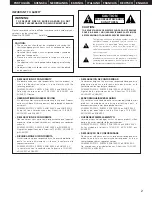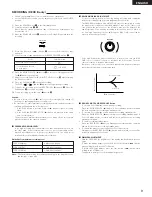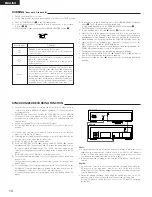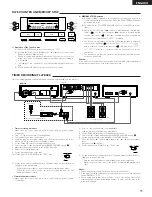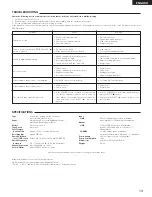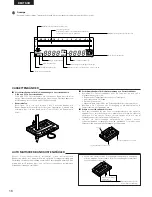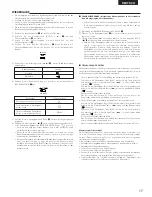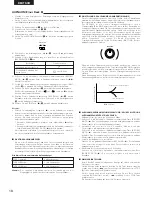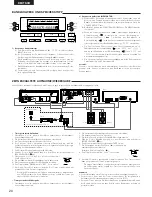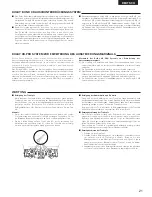
8
ENGLISH
PLAYBACK
•
The operations described below apply to deck A and deck B alike.
•
Switch on your amplifier or receiver.
•
Set the Tape Monitor switch on your amplifier or receiver to the TAPE
position.
•
The numbers in the illustration below depict the order in which operation
steps are carried out.
q
Press the POWER switch
q
to the ON (
¢
) position.
w
Press the EJECT (
5
) button
w
to open the cassette compartment cover
!2
.
e
Load the cassette tape and close the cassette compartment cover
!2
.
r
When listening to a tape that has been recorded with Dolby noise
reduction, set the DOLBY NR switch
y
to match the system used at the
time of recording.
DOLBY NR
B OFF C
t
Press the Direction (
0 1
) button
!6
to select the direction of tape
transport.
Transport Direction
Forward
Reverse
Indicator
y
Select the type of tape transport with the REVERSE MODE switch
u
.
REV. MODE
RELAY
Mode
To listen to one side only
To listen to repeat playback of both
sides
To listen to continuous play back of
both sides and both decks.
Switch position
RELAY
u
Press the PLAY button
!6
to begin playback.
i
Press the stop (
2
) button
!6
to stop the playback.
• In the continuous playback mode (REVERSE MODE set to
),
playback of both tape sides will be repeated 5 times and then stop
automatically.
• If different types of Dolby noise reduction are used for record and
playback, playback response will be adversely effected.
• When power is turned off during tape transport, it may not be possible
to remove the cassette by pressing the EJECT (
5
) button. In this case,
turn on power again before you press the EJECT (
5
) button.
2
RELAY PLAY (continuous playback of the tapes in deck A and deck B)
• Load a cassette tape into deck A and B, and set the Dolby NR button
correctly.
q
REVERSE MODE set to “RELAY”
u
.
w
Press the PLAY button
!6
of the deck you first wish to listen to.
e
To stop relay play, press the stop (
2
) button
!6
of the deck currently
playing the tape.
• Relay play will play decks A and B in succession for 5 cycles, upon which
playback stops. When playback starts from deck B, when switching to
deck A. the first deck A playback cycle will be counted as the second
cycle. The completion of 5 cycles will always be at the opposite side of
the tape in deck B.
2
MUSIC SEARCH SYSTEM
The music search system detects blank sections (lasting for at least 4 seconds)
between selections in order to locate the beginning of selections in the
forward or reverse direction.
1. To advance from the current selection to the beginning of the next selection
(CUE):
Press the PLAY button, keep it pressed in, and press the Fast Forward (
7
)
button when the tape is travelling in the forward (
) direction.
Press the PLAY button, keep it pressed in, and press the Fast Rewind (
6
)
button when the tape is travelling in the reverse (
) direction.
The tape transport indicator flashes.
The deck will skip the rest of the current selection and automatically resume
play from the beginning of the next selection.
2. To repeat playback from the beginning of the current selection (REVIEW):
Press the PLAY button, keep it pressed in, and press the Fast Rewind (
6
)
button when the tape is travelling in the forward (
) direction.
Press the PLAY button, keep it pressed in, and press the Fast Forward (
7
)
button when the tape is travelling in the reverse (
) direction.
The tape transport indicator flashes.
The deck will rewind the tape to the beginning of the current selection and
automatically resume play from that point.
This is very convenient for repeating playback of the current selection.
Notes on Music Search Operation:
The search functions operates by detecting comparatively long, blank sections
approximately 4 to 5 seconds long, in between recorded selections. Therefore,
the system may not operate normally in the following cases:
• Recordings with discontinuous speech or conversation.
• Recordings with long periods of pianissimo (softly played music).
• Recordings with long silences.
• Blank sections with a high level of noise.
• Blank sections shorter than 4 seconds.
• If noise-emitting appliances, such as electric razors, drills, refrigerators, etc.,
are operated nearby.
• REV close to the beginning of the program or CUE close to the ending.


